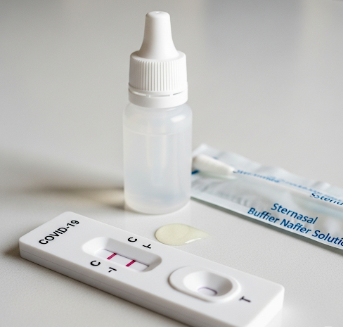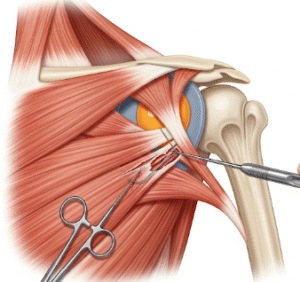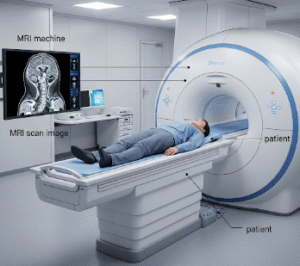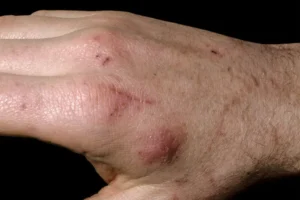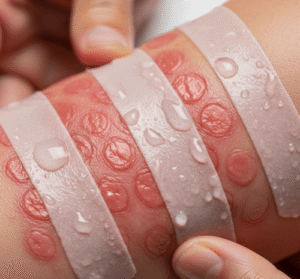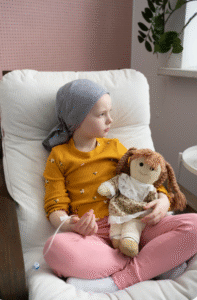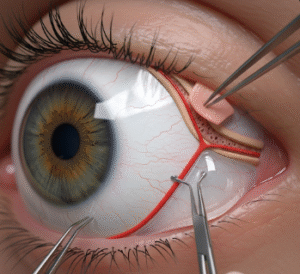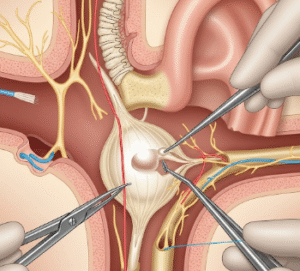Overview
The COVID-19 rapid lateral flow test (LFT) is a point-of-care diagnostic tool designed to quickly detect the presence of SARS-CoV-2 antigens in respiratory samples, usually from the nose or throat. Unlike PCR tests, rapid tests provide results within 15–30 minutes without requiring a laboratory.
Importance of rapid lateral flow tests:
- Enables early detection of COVID-19 infection, including in asymptomatic individuals.
- Helps prevent virus spread by identifying positive cases quickly.
- Supports public health strategies, workplace safety, and travel screening.
- Convenient and accessible for home use or mass testing programs.
In South Korea, rapid lateral flow testing is widely available in hospitals, clinics, pharmacies, and community testing centers, supporting efficient pandemic management and timely isolation of positive cases.
Why It’s Done
Rapid lateral flow tests are performed to identify active COVID-19 infection quickly.
Common reasons for testing include:
- ➤ Symptomatic individuals with fever, cough, sore throat, or loss of taste/smell.
- ➤ Close contacts of confirmed COVID-19 cases.
- ➤ Travel requirements for domestic or international travel.
- ➤ Workplace or school screening to prevent outbreaks.
- ➤ Pre-event screening for gatherings or healthcare settings.
Benefits for patients and public health:
- ✔️ Provides fast results, enabling immediate isolation and treatment.
- ✔️ Identifies infected individuals who may be asymptomatic.
- ✔️ Supports contact tracing and outbreak control.
- ✔️ Reduces pressure on laboratories by offering an alternative to PCR.
- ✔️ Accessible for self-testing at home or at local health centers.
Alternatives
While rapid LFTs are convenient, alternatives include:
- ➤ PCR (Polymerase Chain Reaction) testing: Gold standard with high sensitivity but longer turnaround time.
- ➤ Antibody testing: Detects past infection but not useful for early diagnosis.
- ➤ Clinical assessment: Symptom monitoring and professional medical evaluation.
- ➤ Combination strategies: LFTs followed by confirmatory PCR testing for positive results.
Key point: Rapid LFTs are best used for screening, early detection, and frequent testing, while PCR remains the definitive diagnostic tool.
Preparation
Proper preparation ensures accurate test results and safe sample collection.
Steps include:
- ✅ Read instructions carefully for the specific LFT kit.
- ✅ Wash hands thoroughly before handling test components.
- ✅ Ensure the test kit is at room temperature if stored in cold conditions.
- ✅ Collect the sample correctly: Usually a nasal or throat swab.
- ✅ Avoid eating, drinking, or smoking immediately before sample collection (if instructed).
- ✅ Prepare a clean, flat surface for performing the test.
Important: Correct preparation and sample collection significantly reduce false negatives or invalid results.
How It’s Done
The rapid lateral flow test is user-friendly, minimally invasive, and quick.
Procedure steps:
- Swab collection: Insert a sterile swab into the nostril (or throat) to collect a sample.
- Sample preparation: Place the swab into a test tube or buffer solution to release viral antigens.
- Applying the sample: Add drops of the prepared sample to the test cassette.
- Wait for results: Typically 15–30 minutes.
- Interpretation:
- Positive result: Both control line (C) and test line (T) appear.
- Negative result: Only control line (C) appears.
- Invalid result: No lines or only test line (T) appears, requiring retesting.
Key point: Rapid LFTs do not require laboratory equipment and can be performed at home, clinics, or testing centers.
Recovery & Post-Use Care
After taking a rapid LFT, recovery or next steps involve monitoring health and following public health guidance:
Immediate post-test steps:
- Dispose of test components according to biohazard instructions.
- Wash hands thoroughly.
- Record test result if required for reporting.
Follow-up actions based on result:
- Positive: Self-isolate immediately, inform contacts, and seek confirmatory PCR test if advised.
- Negative: Continue monitoring symptoms and follow preventive measures; retest if symptoms develop or after exposure.
- Invalid: Repeat the test with a new kit.
Long-term outcomes:
- Early detection reduces transmission risk.
- Supports public health monitoring and contact tracing.
- Provides peace of mind and informed decision-making regarding isolation and medical care.
Important: Even with a negative test, preventive measures such as mask-wearing, hand hygiene, and social distancing remain critical.
Possible Complications / Risks
Rapid lateral flow tests are generally safe and non-invasive, but some considerations include:
- ⚠️ False negatives: May occur if viral load is low or sample collection is inadequate.
- ⚠️ False positives: Rare but possible due to test contamination or kit issues.
- ⚠️ Discomfort: Minor irritation or tickling during nasal or throat swabbing.
- ⚠️ Misinterpretation: Incorrect reading of lines or timing may lead to errors.
- ⚠️ Emotional impact: Anxiety or stress from positive results.
In South Korea, test kits follow strict quality control standards, and healthcare providers offer guidance for accurate use and follow-up.
Treatment Options / Clinical Relevance in Korea
COVID-19 rapid lateral flow tests are widely used in South Korea for efficient pandemic control and public safety.
Key features:
- 🏥 Available at hospitals, clinics, pharmacies, workplaces, and schools.
- 🏥 Approved by the Ministry of Food and Drug Safety (MFDS) for accuracy and reliability.
- 🏥 Part of screening strategies for travel, events, and high-risk settings.
- 🏥 Supports contact tracing, quarantine enforcement, and early medical intervention.
- 🏥 Home-based self-testing is supported with online reporting systems and telehealth consultation.
Highlights in Korea:
- ✔️ Rapid LFTs enable mass testing with fast turnaround.
- ✔️ Used for frequent screening of asymptomatic individuals.
- ✔️ Helps maintain public health safety and prevent large outbreaks.
- ✔️ Integration with digital reporting systems enhances tracking and management.
- ✔️ Supports early treatment initiation and reduces hospital burden.
Highlights
- ➤ Rapid lateral flow tests detect SARS-CoV-2 antigens quickly, within 15–30 minutes.
- ➤ Indicated for symptomatic individuals, close contacts, travel screening, workplace or school testing, and pre-event screening.
- ➤ Alternatives include PCR testing, antibody tests, clinical assessment, and combined strategies.
- ➤ Preparation involves reading instructions, hand hygiene, correct sample collection, and following kit guidelines.
- ➤ Procedure is minimally invasive, involves swab collection, sample preparation, application to test cassette, and result interpretation.
- ➤ Post-test actions include disposal, self-isolation if positive, symptom monitoring, and preventive measures even after a negative result.
- ➤ South Korea offers widespread access to rapid LFTs in hospitals, clinics, pharmacies, and home-testing programs, supporting public health and outbreak control.

